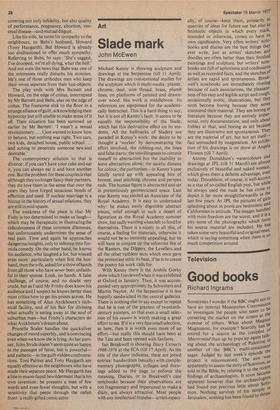Art
Slade mark
John McEwen
Michael Kenny is showing sculpture and drawings at the Serpentine (till 11 April). The drawings are conventional studies for the sculpture which is multi-media: plaster, chrome, steel, wire thread, brass, plumb lines, on platforms of painted and drawnover wood. His work is middlebrow. Its references are signposted for the academically instructed. This is a hard thing to say, but it is not all Kenny's fault. It seems to be equally the responsibility of the Slade, which has this destructive effect on its students. All the hallmarks of Sladery are paraded in Kenny's work : the desire to be thought a 'worker' by demonstrating the effort involved, the rubbing-out, the lines and false starts; the unwillingness to commit oneself to abstraction but the inability to leave abstraction alone; the ascetic distaste for colour; the puritanism—in Kenny's case fatally tarted up with appealing bits of bronze, steel stitching, chrome and perspex rods. The human figure is abstracted and set in pretentiously geometricised space. Last year Kenny was elected an Associate of the Royal Academy. It is easy to understand why: he makes easily digestible abstract pieces, relief enough in such a desert of figuration as the Royal Academy summer show, but sadly wanting when left to fend for themselves. There is a nicety in all this, of course, a feeling for materials, otherwise it would not be so instantly appealing, but he will have to conjure up the reformist fire of the Ranters, the Diggers, the Levellers and all the other ruthless sects which once gave the protestant ethic its heat, if he is to create the poetry his work calls for.
With Kenny there is the Arshile Gorky show which I reviewed when it was exhibited at Oxford in January. Then, it was accompanied very appropriately by Schwitters and Martin Naylor. At the Serpentine it is less happily sandwiched in the central galleries. There is nothing else to say except to repeat that he is one of the greatest of twentiethcentury painters, so that even a small selection of his oeuvre is worth making a great effort to see. [fit is a very fine small selection, as here, then it is worth even more of an effort—but really this should have been at the Tate and been opened with fanfares.
Ian Breakwell is showing Diary Extracts 1968-1976 at the [CA (till 17 April). As the title of the show indicates, these are jotted entries: handwritten (usually) with complementary photographs, collages and drawings added to the page to enforce the meaning. Diaries, or in Breakwell's case notebooks because their observations are too fragmentary and impersonal to make a diary, are always attractive. Most people with any intellectual impulse—artists especi ally, of course—keep them, primarily as quarries of ideas for future use but also aS fetishistic objects in which every mark, intended or otherwise, comes to have its own significance. Very often writers' notebooks and diaries are the best things they ever write, just as artists' sketches and doodles are often better than their finished paintings and sculpture, but writers' notebooks are full of aphorisms and confessions as well as recorded facts, and the sketches of artists are rapid and spontaneous. Break well's notebooks are immediately riveting because of such associations, the pleasantness of his easy and legible script and rough, occasionally erotic, illustrations, but they soon become boring because they never transcend their material. They are boring as literature because they are entirely impersonal, only documentation, and only about foibles at that, and boring as art because they are illustrative not spontaneous. They are the material of art, but not art itself— fact untouched by imagination. An exhibition of his drawings is on show at Angela Flowers (till 7 April). Antony Donaldson's watercolours and drawings at iPL (till 31 March) are almost exclusively of beautiful and naked women, which gives them a definite advantage, even today. Donaldson, of course, is well-known as a star of so-called English pop, but while he always used the nude he has come t° depict it far more straightforwardly in the last few years. At JPL the pictures
splashing about in pools are Californian in attitude. The images handled
hedonistic du nr ensi sonfc with most freedom are the worst, and it is a pity none of the photographs which form his source material are included. He has taken some very beautiful and original ones, which is saying something when there is s° much competition around. gainr Ids


































 Previous page
Previous page